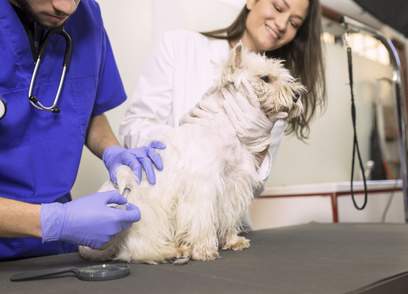
This article was updated on December 12th, 2022
Making the decision to euthanize a dog with Cushing’s disease is not an easy one to make; due to the slow progression of the disease we, as vets, often form strong bonds with affected animals through the many years of management.
The Story of Millie, a Dog With Cushing’s Disease
Millie, a 9-year-old West Highland White Terrier, was one such beloved dog who I recently had to euthanize due to complications related to Cushing’s disease.

Millie first came in to see me two years ago as the owner had noticed her generally slowing down and had become more lethargic. She also had two areas of hair loss on her flanks and upon further questioning, Millie’s owner mentioned that she did also seem to drink a lot more than she used to.
Blood tests confirmed Cushing’s disease diagnosis. Treatment was started and through regular repeat blood tests and slight alterations of the drug Millie was on, she lived a comfortable and happy two years.
How Millie’s Health Situation Deteriorated
Two years past and Millie came back in to see me as the owner had concerns that her demeanor and general behavior had changed; she had even been aggressive with her owner at times.
Unfortunately, Millie went on to deteriorate quickly over the following week and had marked neurological changes.
One form of Cushing’s disease is caused due to a tumor in the pituitary gland: Millie’s symptoms very much fit with the possibility of this tumor enlarging and pressing on the brain, resulting in neurological symptoms.
How the Decision to Euthanize Millie Was Made
At this point, the treatment options that worked so well for Millie would no longer be able to help her in a significant way. The owners realized that:
1) There was no surgical or medical option that could help with the tumor.
2) Millie’s quality of life was quickly deteriorating: she became depressed and lethargic – she’d lost interest in life and her usual activities, likely due to the presence of a brain tumor.
So the owners realized that euthanasia was the best option and decided to have Millie put to sleep. They took solace in the fact that Millie had lived a happy life up until this point despite being diagnosed with Cushing’s disease.
In this article, we will first review helpful information about Cushing’s disease, before discussing treatment options, chances of survival, and finally important factors to consider when trying to decide when to euthanize a dog with Cushing’s disease.
What is Cushing’s Disease?
Cushing’s disease is a challenging condition for both dogs and their owners to live with; it requires lifelong medication and frequent check-ups once the diagnosis has been made. It’s hard to see our pets gradually deteriorate over time as they age, and although Cushing’s is a disease that can be generally well-controlled, there may come a point where your dog’s symptoms continue to worsen despite our best interventions as a vet.
There may also be other complications related to Cushing’s disease, like neurological issues as in Millie’s case.
Cushing’s disease, or hyperadrenocorticism, is a hormonal disorder in which the adrenal glands produce too much of a steroid hormone known as cortisol. Cortisol is vital in the right quantities; it regulates the ‘fight or flight’ response, allowing more glucose to be released into the bloodstream in times of need. This glucose is quickly broken down to release the energy required by muscles for contraction.
However, in the case of Cushing’s disease, there is a constant surplus of cortisol. This results in a persistent state of stress and anxiety.
Symptoms associated with high levels of cortisol include lethargy, weak muscles, increased thirst and urination, weight gain, pot-belly appearance, hair loss, thin skin, and a weakened immune system. There are three types of hyperadrenocorticism:
- Pituitary-dependent: A benign tumour in the pituitary gland causes an overproduction of a hormone called ACTH. An excess of ACTH then overstimulates the adrenal glands to produce more cortisol. This is the most common form of Cushing’s disease accounting for approximately 85% of cases.
- Adrenal-dependent: A tumour (usually benign) within the adrenal glands themselves results in an overproduction of cortisol. This is a less common form of the disease.
- Iatrogenic: Long term steroid medication, such as prednisolone, results in Cushing’s symptoms.
What Treatment Options Can Help Avoid Euthanizing a Dog with Cushing’s Disease

What treatment options are available with Cushing’s disease?
The treatment for your dog’s Cushing’s disease will depend on the type of hyperadrenocorticism they have and the severity of symptoms that they are displaying. Once dogs are diagnosed with Cushing’s disease, they cannot be cured – lifelong medical management will be required.
Medical treatment is used to control the symptoms of Cushing’s disease by inhibiting the production of cortisol. While both forms of the disease respond to medical treatment, there is a surgical option available for adrenal-dependent Cushing’s disease.
Two drugs are commonly used: Trilostane and Mitotane. Of the two, Trilostane is the most effective and has the least side effects. Other drugs such as selegiline hydrochloride and ketoconazole are available but are not as effective as the two medications mentioned above.
In the case of adrenal-dependent hyperadrenocorticism, surgical resection of the adrenal tumor is a possible treatment, but this is regarded as a specialist and highly invasive procedure.
If iatrogenic Cushing’s disease is present then the treatment is to gradually stop giving your dog steroid medication – this should be done in a controlled manner as suddenly stopping steroid medication can have undesirable side effects. There are cases however where this steroid medication is required to treat a different more sinister disease, so the decision may be made to keep your dog on steroids. You should always talk to your vet before stopping any medication.
What is the survival rate of Cushing’s disease?
The survival rate of Cushing’s disease depends on multiple factors, including when the disease is diagnosed, what form of Cushing’s disease your dog has and how soon treatment is started. While most dogs with Cushing’s can continue to live a happy and healthy life once on medication, the disease does inevitably shorten their lifespan.
According to this study, the median survival times for a dog with pituitary-dependent Cushing’s disease that is undergoing treatment is between 549-930 days (roughly 1.5-2.5 years). There have been no large-scale canine studies into survival times for untreated dogs. However, if human Cushing’s disease can be used as a model then survival times can be expected to be less. Dogs left untreated usually die of complications associated with the disease such as secondary infections, blood clots and cardiovascular disease.
Other studies also show no major difference in survival rates between dogs treated with trilostane and mitotane. However, due to having less frequent and milder side effects, trilostane is often used as the first line treatment.
It is clear therefore that treatment is necessary for Cushing’s disease. While a dog left untreated for Cushing’s disease may continue to live for many years, it is likely that their quality of life will be significantly reduced due to the marked side effects of the disease. In contrast, dogs treated for hyperadrenocorticism who have regular check-ups can continue to live with a high quality of life.
How to Make the Decision To Euthanize a Dog With Cushing’s Disease
What stage of the disease is your dog at?
Dogs with Cushing’s disease will have varying symptoms depending on how far progressed through the disease timeline they are. The first symptoms are often subtle: lethargy, panting and increased thirst or urination.
So what are the signs that your dog may be dying from Cushing’s disease? As the disease worsens, dogs will often develop a pot-bellied appearance, lose fur on their flanks and develop thin skin as well as having recurrent infections due to an impaired immune system. While treatment aims to control these symptoms as best as possible, hyperadrenocorticism is a disease that gradually becomes harder to control as the tumor present in the pituitary or adrenal gland enlarges.
A dog in the end stage of Cushing’s will be refractory to changes in medication; they are likely on the highest possible dose of trilostane. Because of this, their symptoms will often start to recur to the point where they are extremely lethargic, have uncontrollable thirst and/or urination, and have repeated infections such as skin infections or urinary tract infections.
One concern, as in the case of Millie at the start of this article, is that of neurological changes developing. Dogs with the pituitary-dependent form of hyperadrenocorticism can start to develop neurological abnormalities as an expanding pituitary gland tumor puts pressure on the surrounding brain tissue. If your dog is displaying symptoms such as nervousness, aggression, disorientation, circling or even seizures then a pituitary tumor is the likely cause. Unfortunately, not much can be done in this case if they are non-respondent to increased doses of medication.
When should you euthanise a dog with Cushing’s disease?
Making the final decision to euthanize a dog with Cushing’s is not an easy one to make. Hyperadrenocorticism tends to be a slowly progressing disease in which symptoms gradually worsen over time. As such, there is usually not a clear-cut moment when a dog deteriorates. This can make it difficult for an owner to make a rational decision – their pet’s condition might wax and wane and it is hard to notice differences in a dog’s condition when these changes occur over long time spans.
The decision you make must be a selfless one. If your dog doesn’t do much but sleep and eat, and if their Cushing’s symptoms are unmanageable then it might be the time to have them euthanized. If medication is no longer keeping symptoms at bay then your dog may be in a constant state of stress and anxiety, and any neurological issues, unfortunately, mean a poor prognosis.
Your dog’s quality of life is the most important consideration when deciding when to euthanize. Ask yourself:
- Do they still seem interested in their favourite things and are they still excited to greet you when you come home?
- Do get out of breath easily and are they reluctant to do any form of exercise?
- Do they get repeated infections?
- Are they constantly wanting to drink more water and do they pee around the house?
- Do they show any neurological abnormalities?
If the answer to these questions is not a positive one then it is the right time to consider euthanasia – talk to your vet as they can help you come to the right conclusion.
Steps we recommend when deciding to euthanize
Seeing your companion gradually deteriorate is heart-breaking and although it is hard to be rational in these situations, you must put the welfare of your dog first. The ability to perform euthanasia is a blessing; it allows vets and owners to bring an end to an animals’ suffering and allows them to pass with dignity, so take solace in that fact.
To help you come to the right decision, follow these steps:
- Talk to your vet – Questions to Ask Your Vet to help with Decision on When to Euthanize:
- What stage of Cushing’s disease is my dog in?
- Are there any other treatment options available?
- What is their survival rate with and without treatment?
- What symptoms should I look out for that might mean my dog needs euthanizing?
- Take our quiz to help you evaluate your dog’s quality of life. https://seniortailwaggers.com/quiz-it-is-time-to-euthanize/
- Ask your vet what the process entails. If you have concluded that euthanasia is the best thing for your dog, ask your vet what the process entails. Most veterinary clinics will allow the owner to be with their dog at the time of passing and some may even be able to arrange a home visit to allow your dog to be as comfortable as possible. Being prepared for what the euthanizing process involves will prevent any shocks or anxiety leading up to the event; that way you can concentrate on being there for your canine friend.
Related Posts about Cushing’s Disease:





Disclaimer: This website's content is not a substitute for veterinary care. Always consult with your veterinarian for healthcare decisions. Read More.





Be the first to comment